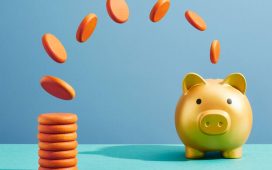Key events
Breakfast cereal, crisps, vegetables become cheaper
Here’s more detail on what happened to food prices. Breakfast cereals, potato crisps and bars of chocolate have become cheaper.
The main downward effects on the inflation rate came from bread and cereals, vegetables, and sugar, jam, syrups, chocolate and confectionery. In each case, prices fell between April and May this year, compared with a monthly rise a year ago.
The resulting annual rates were the lowest since October 2021 for the first two categories and since June 2022 for sugar, jam, syrups, chocolate and confectionery, the statistics office said.
Annual rates eased in nine of the 11 food and soft drink categories, with the exception of oils and fats, and milk, cheese and eggs.
Rachel Reeves, Labour’s shadow chancellor, said:
After 14 years of economic chaos under the Conservatives, working people are worse off. Prices have risen in the shops, mortgage bills are higher and taxes are at a 70-year high.
Labour has a plan to make people better off bringing stability back to our economy, unlocking investment and delivering reform. All the Conservatives are offering is a desperate wish list of unfunded spending promises that will mean £4,800 more on people’s mortgages.
The choice at the election is simple: stability with Labour that will make Britain better off or five more years of chaos with the Conservatives that will mean higher mortgages.
TUC general secretary Paul Nowak said:
Over the last three years UK families have suffered the highest prices rises in the G7 – with inflation going up more over that period than it usually does over an entire decade.
Ministers can try to rewrite history all they like. But the Conservatives have presided over the worst period for living standards in modern times.
Food and energy bills have surged. Rents and mortgages have skyrocketed. And real wages are still worth less than in 2008.
Working people have paid the price for this government’s failure with household debt also increasing at record levels. We can’t go on like this. We need a government that will make work pay.
Jake Finney, economist at PwC UK, said today marks a “decisive moment in the fight against inflation,” as it is the first time CPI inflation has returned to the Bank of England’s 2% target in almost three years.
This is the longest period that inflation has exceeded the 2% target since the early 2010s, when it took four years to return to target. However, during that period inflation only peaked at 5.2%, compared to a peak of 11.1% in October 2022.
Consumer prices have risen by 20% since inflation was last at target. In the three years prior to this inflation episode, prices had risen by just 5%. That means the cumulative increase in prices has been roughly four-times faster than in more normal times. The one saving grace for households is that nominal earnings have increased by 18% over the same period, preventing a sharper decline in living standards.
However, it is not ‘job done’ yet. If prices continue to rise at the same month-on-month rate as they did this month (0.3%), then headline inflation will be back over the 2% target next month (at 2.1%). This is because underlying momentum remains above levels that are consistent with the 2% target, particularly with regards to services inflation.”
Here is some instant reaction.
Luke Bartholomew, deputy chief economist at the asset manager abrdn, said:
The fall of headline inflation back to target was expected, but will still come as extremely welcome news to the Bank of England. The big question now is whether underlying inflation pressures in the economy are consistent with inflation staying around 2% in the medium term, or whether inflation will start to edge higher again once favourable base effects fade.
On that front, there is still evidence of residual stickiness in services inflation, reflecting the strength of wage growth recently. That is why an interest rate cut tomorrow is still very unlikely. But we think the Bank’s communication tomorrow will set out a path for a cut in August, which is now looking increasingly likely.
Food price rises ease to lowest rate since 2021
It is the first time inflation has met the Bank of England’s 2% target since July 2021.
This is mainly because food price rises have eased. Prices of food and soft drinks rose by 1.7% in the year to May, down from 2.9% in April, and the lowest rate since October 2021.
Food price inflation has eased for 14 months from a peak of 19.2% in March last year, the highest annual rate seen for more than 45 years.
Here is our full story:
UK inflation slows to official target of 2% for first time since 2021
Inflation in the UK has fallen to an annual rate of 2% in May, as expected.
It’s down from 2.3% in April, according to the Office for National Statistics.
Core inflation which excludes food, energy, alcohol and tobacco, as they tend to be volatile, has slowed to 3.5% from 3.9%, also as expected.
In the 12 months to May 2024:
· Consumer Prices Index (CPI) rose by 2.0%, down from 2.3% in April
· Consumer Prices Index including owner occupiers’ housing costs (CPIH) rose by 2.8%, down from 3.0% in AprilRead Consumer price inflation ➡️ https://t.co/fDtPVw0dL1 pic.twitter.com/nJcbUU41AQ
— Office for National Statistics (ONS) (@ONS) June 19, 2024
The largest downward effects came from food and soft drinks, recreation and culture, and furniture and household goods. Transport, namely fuel, provided the largest, partially offsetting, upward contribution.
Unsecured household debt to rise by £1,660 this year
Unsecured household debt is set to rise by more than £1,600 this year as families continue to struggle with the cost of living crisis, according to new TUC analysis.
Unsecured debt (loans, credit cards, purchase hire agreements) is on course to increase by 9.4% in real terms (adjusted for inflation), on average, per household this year. Over a quarter of people say they have taken out loans or borrowed on credit cards to cover unexpected bills since the start of the year.
The TUC says that this is the largest annual rise – in cash terms – since records began in 1987. The union body says the findings make a mockery of government claims that “their plan is working”.
The analysis excludes student loans.
Separate TUC polling, carried out by YouGov, shows that millions are continuing to struggle with the cost of living:
-
4 in 10 (42%) say they’ve cut back on essentials like food and utility spending this year. And this number rises to nearly 1 in 2 (47%) for women.
-
6 in 10 (60%) say they have cut back on non-essential spending like dining out and entertainment since the beginning of the year.
-
Nearly a fifth (19%) of respondents say they have fallen behind on household bills this year – a number that rises to over 1 in 4 (28%) for people aged 18-24.
-
Over quarter (27%) say have they taken out debt (loans, credit) to cover unexpected bills since the start of the year. This number shoots up to over a third (37%) for adults aged 25-49 – when lots of families raise children.
UK workers are on course for nearly two decades of lost living standards, with real wages not forecast to recover to their 2008 level until 2026.
The TUC estimates that the average worker would be £14,700 better off if their pay had grown at the same pace as pre-financial crisis real wage growth trends since 2008.
Its general secretary Paul Nowak said:
These findings show out of touch this Conservative government is with people’s struggles. While the Tories boast about their plan working, households across Britain are being pushed further into debt.
No one should have to rely on credit cards and loans to make ends meet. But after 14 years of flatlining wages – and the worst cost of living crisis in generations – many families are at breaking point.
The Tories economic record speaks for itself. Pay packets are still worth less today than in 2008 with working people on course to end this parliament poorer than at the start.
Introduction: UK inflation expected to fall back to official 2% target
Good morning, and welcome to our rolling coverage of business, the financial markets and the world economy.
It’s UK inflation day!
In just a few minutes, we will find out whether inflation across the country has continued to slow, to the official target of 2%.
Economists are predicting that the headline annual rate fell to 2% in May from 2.3% in April, partly because of lower energy prices. That was the lowest rate in almost three years, although the decline was smaller than expected, and dashed hopes of an early interest rate cut.
The Bank of England is mandated by the government to keep consumer price inflation at an annual rate of 2%. The figures are released at 7am BST by the Office for National Statistics.
Core inflation which excludes food, energy, alcohol and tobacco, as they tend to be volatile, is forecast to have fallen to 3.5% from 3.9%. The central bank will keep a close eye on the services inflation number, which remained at 5.9% in April.
Investec economist Sandra Horsfield said:
UK inflation has certainly come a long way since the monetary policy committee (MPC) last hiked rates in August: the latest consumer price index (CPI) outturn the MPC faced at that time was for June 2023, when headline inflation was 7.9% year-on-year and core inflation 6.9%. By April 2024, the corresponding rates reached 2.3% and 3.9%, respectively.
We see a number of factors as likely to have pulled down inflation. One is that goods price inflation remains on a downward trend: lower energy prices are still gradually filtering through supply chains, and import prices are falling as China leans on manufacturing exports as an engine of growth. On the services side, wages continue to add to firms’ costs; but even there, the trend in wage growth is downwards, if only moderately. This should have added up to a lower rate of ‘core’ inflation.
We will also get producer price figures, which measure factory gate inflation – this eventually feeds into consumer price rises.
The Agenda






